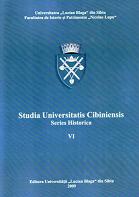Naşterea şi formarea identităţii confesionale luterane în Transilvania: între exigenţe teologice şi constrângeri politice
The Birth and Formation of the Lutheran Confessional Identity in Transylvania: Between Theological Requirements and Political Constraints
Author(s): Edit SzegediSubject(s): History
Published by: Editura Universitatii LUCIAN BLAGA din Sibiu
Keywords: Reform; theological syncretism; Crypto-Calvinism; Lutheran orthodoxy; confessionalization
Summary/Abstract: The current research attempts to reconstruct the formation of the confessional identity among the Saxons in the period 1543-1653, a topic that has been neglected by historiography. Contrary to the image that persists among the non-theologians, the Lutheran identity of the Saxons was the result of a slow evolution that lasted for a century, being strongly influenced not only by theological debates, but also by political constraints, especially in the first half of the seventeenth century. Starting from the profile of the Reform in Braşov, which tried to mediate among the various theological currents, this theological syncretism being typical of Central-Eastern Europe, Church of Augustan (Augsburg) Confession in Transylvania wavered between Lutheranism and Crypto- Calvinism or the mediating Melanchthonian theology, the former current becoming dominant towards the end of the sixteenth century. At the beginning of the seventeenth century, one witnesses even a Calvinizing tendency. The situation changed once with the Synod of 1615, which imposed the orthodox Lutheranism. This change is intelligible not only from the perspective of the theological evolution of the other confessional churches towards dogmatic rigor, but also from that of the political situation in Transylvania, marked by the rise of the Reformed princes and especially by the traumatizing experience of the reign of Gabriel Báthori, who infringed upon the Saxon privileges. Under the circumstances in which the Reformed princes were ready to reprimand any doctrinal deviation, the option for the orthodox Lutheranism remained the only valid one. The completion of Lutheranization roughly ended only at the half of the seventeenth century, once with the doctrinal integration of the Hungarian communities from the Bârsa Land and the Bran domain as well as the disciplining of the Calvinizing clergy from the deaneries in Sighişoara and Rupea.
Journal: Studia Universitatis Cibiniensis. Series Historica
- Issue Year: 2009
- Issue No: VI
- Page Range: 117-148
- Page Count: 32
- Language: Romanian
- Content File-PDF

